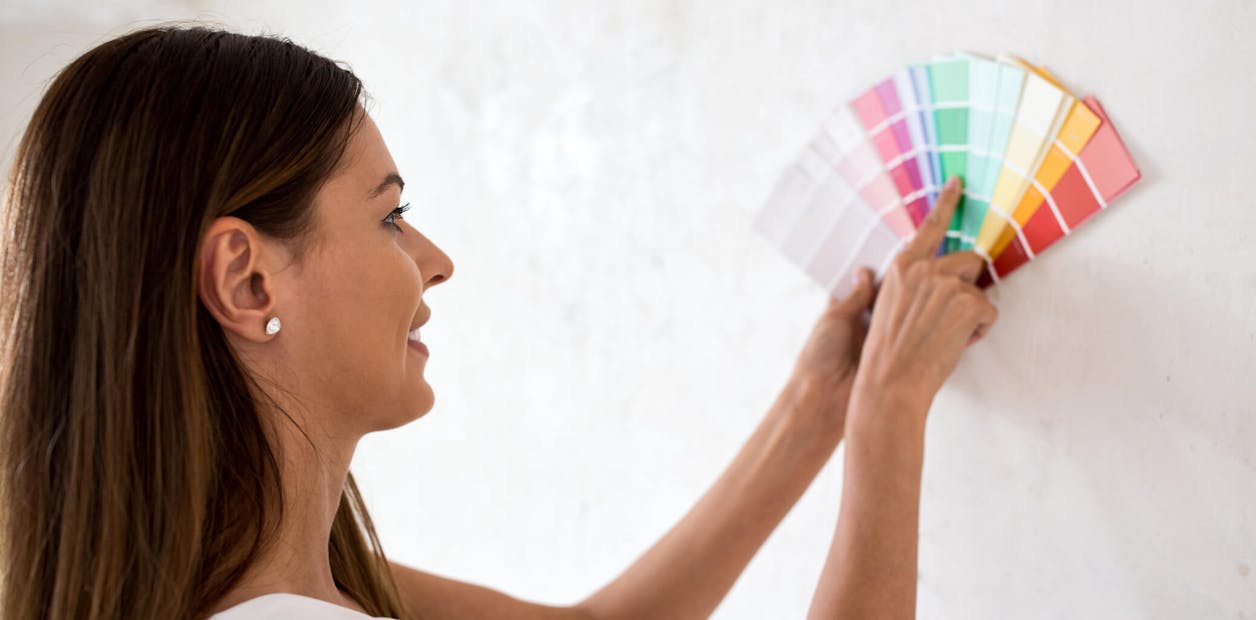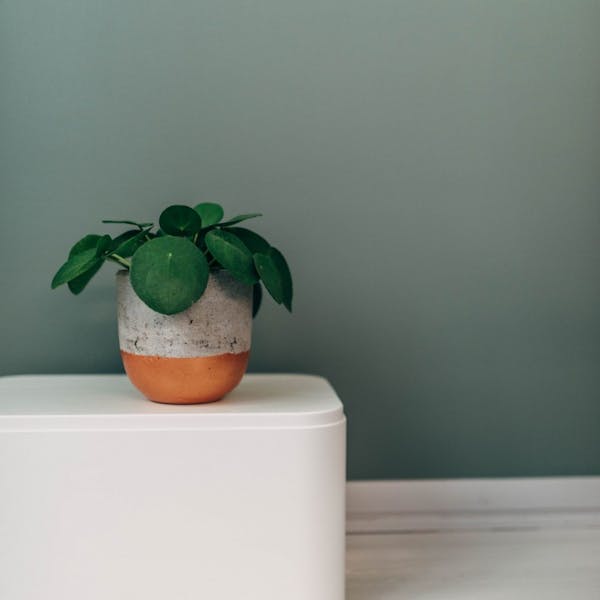Choosing the right colour scheme for your home is undoubtedly the most important decision you will make when decorating your home. Each shade you choose has the ability to shape the atmosphere, mood, and leave a lasting impression on anyone who walks through your door.
Tactical paint colour choices don't only allow us to create on-trend, visually appealing spaces but can also solve common problems we wrestle with while trying to plan out our interiors.
Does your space feel a little cramped? Unsure how to decorate a north-facing room? Or is a space not extruding the calming and relaxing vibe you aimed for? All of these problems and more can be easily addressed with smart paint colour choices.
By the time you have reached the end of this article, you will have all of the information you need to turn any space in your home into an on-trend, stylish space.
So, join us as we embark on a journey covering everything you need to know about creating harmonious colour palettes that don't only complement your home's architectural elements but also align with your unique style.
From popular colour and design trends to considerations to take selecting your shades, this detailed guide will help you turn your house into your dream home.

Determine Your Personal Colour Preferences
Often we have a bit of a vision of what we would want our space to look like or certain shades we would like to integrate into a colour palette for a space.
This is a brilliant starting point for any project.
Take a minute to reflect on personal tastes and your favourite colours looking at specific hues you may want to shortlist. A great place to explore your options is the Tikkurila colour directory. With thousands of shades to choose from you are bound to find one that matches your needs.
Don't worry if you are picturing a particularly vibrant or adventurous colour. There are many ways to work bolder or more uncommon shades into a colour scheme. We will cover this in-depth later.
Assess the Existing Elements of Your Home
Before you leap ahead and settle on paint colours or buy sample paint pots you will need to evaluate the existing elements of your home.
This quick assessment acts as a foundation for your colour scheme ensuring that your colour choices harmonise with the styling and characteristics of your space.
Let's take a look at a few of the main elements you will need to consider before moving on to selecting colours.
Consider Existing Architectural Features
Architectural features are going to be one of the most expensive aspects of your decor to change, so it is better to consider this factor very early on in the process and allow it to influence the colours you choose.
A few of the most common features you may come across include exposed brick, wooden beams, fireplaces, archways, or panelling. You will often want to highlight some of these features enabling them to become focal points in your space.
Where this part of the puzzle can most often trip people up is when dealing with more traditional spaces with a distinctly classical vibe. While it is possible to bring a modern appeal to that type of space, it does require a bit more careful planning.
Analyse Natural Light
When decorating natural light is your best friend. It has an unrivalled ability to make a room feel spacious, open, and airy. Having an abundance of natural light also makes it far easier to bring darker shades into your decor without much risk of making a room feel a little claustrophobic.
The absence of it, however, does hem you in a bit more when it comes to colour choices more or less ruling out the use of deeper shades of paint for the same reason outlined above.
Evaluate Existing Furniture and Decor
Another factor that will play a role in the colours you would choose is the existing furniture and decor of your space.
Furniture is expensive and likely not something you would be looking to adjust around your interior design. Consider the style and colour of your furniture and the colours that will work and integrate best with it.
Creating a new colour scheme doesn't mean you have to change every single colour in your home to achieve your goals. There are likely parts of your decor that you would be able to keep and build on. This will significantly reduce the cost and time it takes to redecorate your home. A great incentive to find ways to work with what you currently have.

Understand Colour Theory and its Application in Interior Design
Colour theory is the art and science of using colours, understanding how they interact, can influence mood and can work together in a harmonious way. Undoubtedly something anyone about to plan a colour scheme could benefit greatly from.
The Colour Wheel
The colour wheel is something you have likely come across whilst at school, or if you were to have any further education in design. It is a chart that organises colours across the visible spectrum sequentially into primary, secondary, and tertiary shades.
Going past the composition of the wheel let's talk a little about how to interpret and leverage the colour wheel to help you create stunning colour palettes for your next interior design project.
Complementary, Analogous, and Triadic Colour Schemes
Complementary colours sit opposite each other across the colour wheel. Pairing these shades together creates vibrant contrasting tones that work together. An example here could be orange and blue, such as Bast G405 and Indigo L429. A great combination for giving a space a sense of depth with the deep blue shade on an accent wall.
Analogous colours are ones which are adjacent to each on the wheel and tend to create a softer, more serene colour scheme. Think yellows and oranges like our Gardenia F309 and Siesta J407. The perfect pairing for creating a relaxing escape.
Triadic colour schemes leverage three colours evenly spaced around the colour wheel. With an extra colour in the mix here, it may feel more challenging to settle on three colours which can work seamlessly together.
Luckily, creating triadic colour schemes is still quite a straightforward task with a colour wheel. To give you a little inspiration and an example you could create a colour scheme with blue, pink, and orange. This could look be Vesuvio Fresco, Petrol S491, and Riviera Y406. As a light pastel colour, Riviera would make a great base colour with the depth of Petrol S491, and the slightly muted, peachy appeal of Vesuvio Fresco draws attention and give a space more visual interest.
Monochromatic, Achromatic, and Neutral Colour Schemes
Veering away from colour schemes you would find on a colour wheel we have monochromatic, achromatic, and neutral colour schemes to talk about next.
Monochromatic colour schemes just use different shades or tones of a single colour to create a colour scheme. This can be a very hard one to get right and may have you spending quite a bit more time trying different shades out with tester pots before committing to full tins. To give you an example of how you may leverage a monochromatic colour scheme here is a blue one using Glacier Y435 and Royal M436.
The word achromatic means without colour, an interesting word to associate with a colour scheme. Essentially the only colours that would be featured in an achromatic palette would be white, black, and grey paint colours.
Even though this option would sound very restricting, and it is, there are many ways you can leverage it to create a stunning space. Our go-to option here would be to pair unaltered white with a stylish grey shade such as Agate N500 or Surf S500.
Lastly, but by no means least we have neutral colour schemes. Neutral shades are not colours you would find featured on a colour wheel and include colours such as cream, tan, beige, or off-whites. This group of colours have become staples of modern interior design and serves as a brilliant alternative to classic white paint colours.
They also tend to remain in-trend and pair well with any other colour. A strong point in favour of including one of these colours in your next decorating project. As off-whites are white plus another colour these shades can project a wide range of vibes. This could be a cool, relaxing feeling from shades with a blue undertone to a warming appeal for those with a slight brown or orange hue.
To show you how versatile and diverse these colours can be a few of our favourite neutrals and off-whites include Damask F485, Halo F462, and Snowdrift L503.
Choose a Colour Scheme that Complements Your Home's Style
Not all colour schemes work in every home, while many colours or palettes can traverse different styles of home there are a few specific considerations you should have when choosing paint colours.
There are only a handful of styles of home you could have. This includes contemporary, minimalist, traditional, rustic, or eclectic. Picking the right colours for each of these can help enhance unique characteristics and bring your vision to life.
Let's take a look at each of these in turn.
Contemporary
If you are looking to decorate a contemporary space you have quite a lot of freedom when choosing paint colours.
A few of the most popular colours to lean on off whites or neutral shades as a base colour and build on it with more adventurous, bolder tones to add depth or energy. In terms of accent shades, you can pretty much use anything you like. A couple of suggestions for vibrant hues would include Flamingo K319 and Folklore S315.
The goal in these spaces is often to underscore sleek lines and bring simplicity which are the hallmarks of modern interior design.
Minimalist
Minimalist design is one of the most popular trends you'll see in modern design. The focus of this trend is simplicity, functionality, and achieving a balanced space with as few components as possible. It takes a little influence from traditional Japanese design and architecture. Essentially this trend is all about less is more.
There are a few things you will want to consider if you are looking to integrate this design style into your home when choosing a colour scheme. This could be opting for fewer colours in your palette and favouring simpler shades that contribute to an open and relaxing vibe.
Traditional
Heading to the other end of the spectrum we have traditional homes. This group would include more period design trends such as Victorian, Georgian, or Edwardian, for example. We do have detailed guides on choosing paint colours for all period-styled homes, check those out if that is what you are looking to do.
Typically it is the type of home you have and its architectural features that will dictate which guide you would want to follow.
Speaking broadly traditional colour schemes do tend to feature rich, deep colours such as navy blues, forest greens, or darker shades of red. You could also further enhance the elegance a classically inspired colour palette brings with a touch of beige or a delicate muted tone.
Choosing the right paint colours is only one aspect of this design style learn more through our guides above.
Rustic
Rustic design styles are more associated with farmhouse styles, or a nature-inspired palette. Expect to find warm and earthy tones featuring heavily in rustic colour schemes. You will also find forest greens, soft neutrals and rustic reds to bring a settling cosy, down-to-earth appeal.
You can introduce this style into most spaces, though it doesn't tend to naturally work as well in traditional homes.
Eclectic
Eclectic design is a design trend that pulls together elements from various styles, time periods, trends, or cultures into a highly individualistic and personalised space. Opting for this style for your interior is sure to make your home completely unique and quite possibly one of a kind.
As you may imagine, this decorating trend really opens your options up when choosing each aspect of your interior colour scheme.
You may want to move forward with this trend carefully seeing how it brings together random parts of interior design that are not typically paired. Without proper planning, this can quickly turn into a bit of a mess or see the parts of your room clash.
Typically vibrant and varied shades are the best suited in Eclectic design. Do try to balance these out with softer neutral tones to avoid overwhelming.
Incorporate Colour Balance and Visual Weight
Like anything, there are 'rules' to interior design. Knowing a few of the key considerations can arm anyone looking to select a colour scheme for their own home into a professional interior designer.
Well, maybe not quite, but you will know how to create a balanced colour scheme for any space.
To help you learn the ropes of creating colour schemes here are a few points you should bear in mind when choosing shades.
The 60-30-10 Rule
One way to structure your colour scheme that is bound to create a balance, attractive space where no one shade feels overwhelming is the 60-30-10 rule.
The idea is that you use one shade 60% of the time, another for 30%, and another for the final 10%. In practice, this could be the main wall colour as your 60%, a complementary shade that is 30% of your decor, and a more adventurous hue that accounts for the final 10% for trim or drawing attention to a specific area.
Do keep in mind that this doesn't just include your paint colours. All aspects of your interior design in your 60-30-10 breakdown. This means you could make your 10% up with other aspects such as furniture, artwork, a rug, or accessories. Your imagination is the only boundary there when it comes to creating a stunning interior with this widely applicable design rule.
Creating Focus Points
While selecting the paint colours you would want to feature you should also consider the layout of the room and any specific features you would want to draw attention to or segregate visually.
Clever paint selection is a clever way to achieve this. A carefully crafted palette can work wonders.
One example of how you could work this in could be in a room that functions as both a kitchen or living room and dining room. By choosing a different paint colour for the dining room part you would be able to you can create a visual separation of the two areas.
This could be your 30% shade as detailed above.
Natural Light Matters
The amount of natural light your space gets will directly impact the types of paint colours which work best in your space.
If your space does not get as much natural sunlight you will want to veer towards lighter hues as the main aspects of your colour palette. Rooms that benefit from a lot of natural light have a bit more freedom to explore deeper colours which absorb some light.
Balancing Colours
No matter how bold or daring of a colour you have in mind for your interior, there is a way to use it in a colour palette. The only consideration you will need to have is how well this works with the other shades in your palette and how predominantly this shade can reasonably feature in your space.
The goal is to balance shades. Find complementary colours that make each other better and project a balanced vibe.
Exploring different hues with tester pots is going to be the key here. I won't dive too deep into that here though as we will be talking about this in quite a bit of depth next.
Test Your Chosen Colour Scheme Before Committing
Decorating a room takes a lot of time, and effort, and can be quite expensive. Not something you would want to undertake without being very sure of your colour choices. This is where sample tester pots, colour cards, and digital mood boards can come in very useful by allowing you to trial and test your ideas until you are certain you have the right collection of colours for your space.
Let's take a look at each method you should consider when testing colours for your interior.
Digital Mood Boards
One of the simplest ways to explore colour is with a digital mood board. The goal here will just be to find paint colours, pictures, or other sources of inspiration and bring them together into something like a collage. See how colours look next to each other and let your imagination guide your decision-making.
There are plenty of easy-to-use online tools you can get started with here. It can be quite a fun activity and often offers a lot of insight into which paint colours you may want to explore further.
Paint Swatches and Samples
An evolution on the above step would be to see how colours look in your home. There are many factors which can influence the way your colours appear on your walls. This is a key reason that testing colours out through colour cards, chips, and paint sample pots is a great idea.
For example, there can be a bit of a difference between how the hue appears on your screen when viewing our colour directory and how it looks on your wall depending on the monitor you are viewing it on and its settings.
Even once you have your tester pot how it looks on your wall can vary depending on a few factors such as the type of light as natural light and artificial light can make a colour appear a little different. The time of day you are looking at it can impact its appearance as depending on which direction the room is facing it can get light at different times of the day which can benefit warmer or cooler colours depending on the its direction and when you use the space.
Have your tester paint pots on a wall for a few days and try to look at them at different times to see how the colours appear at different times of day and lighting conditions.
Tips for a Cohesive Colour Scheme Throughout Your Home
If you have made it this far you will be a pro when it comes to choosing shades for your home. We still have a couple of insightful tips worth considering when creating colour schemes.
Consider Adjacent Rooms
Redecorating a space isn't only about the appearance of the room itself, but also how it ties into the rest of your home. It is all well and good to create a balanced, on-trend, stylish space but if it stands out against the rest of your home it may not have the desired effect.
At an extreme, this could be redecorating a room into a stunning example of contemporary decor in a home which otherwise leverages traditional design. The odds are no matter how well you have selected your colour scheme it will appear a bit out of place.
Try to keep adjacent rooms in mind when decorating to keep a little continuity between spaces and avoid jarring changes.
The same way you think about how colours work next to each other when creating a colour palette for a room you should also consider how well it flows from one space to the next.
Get this bit right and your entire home will feel like it has been planned out by an interior designer.
Colour Repetition and Flow for Smooth Transitions
One way to keep a sense of continuity throughout your home is to try to feature colours (or suitable complementary colours) from one room to the next.
Of course, you will not want to have the same few shades featured across your whole house, this would be quite boring and is definitely not what I am suggesting.
Maintain a Balance Between Warm and Cool Tones
Another consideration you should have when choosing colours for your home is the type of shades you are choosing.
This point goes beyond colour preferences and trendy shades you may want to feature and takes other aspects into consideration for your design, such as the direction your room is facing.
We have touched on this point a little before but to give you a concise explanation to use a rule of thumb here south-facing rooms benefit from cooler hues to combat the extra sunlight they receive while north-facing spaces fare better with warmer paint colours to work against the cooler natural light they have.
The type of colours you should use in East and West facing spaces vary depending on when you use the room. East-facing rooms tend to get a bit more natural light in the morning while west-facing spaces get it in the evenings. Plan your colour scheme accordingly and you will make great use of your space.
Ready to Get Started?
If you have made it this far you have all of the information you could need to turn any space in your home into a stylish retreat.
From identifying the colour schemes and palettes you would like to use and leveraging the tips, tricks, and considerations used by professional interior designers when creating colours schemes you will have no problem finding the information you would need to create balance and visual appeal in your home.
If you are looking for a bit of room-specific guidance we have 100s of articles on all spaces in the inspiration part of our site or take a dive into our vast colour directory would just like to explore possible paint colours.





























